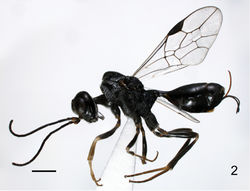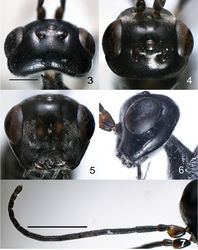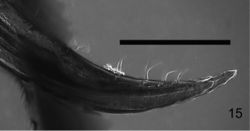Aulacus machaerophorus
| Notice: | This page is derived from the original publication listed below, whose author(s) should always be credited. Further contributors may edit and improve the content of this page and, consequently, need to be credited as well (see page history). Any assessment of factual correctness requires a careful review of the original article as well as of subsequent contributions.
If you are uncertain whether your planned contribution is correct or not, we suggest that you use the associated discussion page instead of editing the page directly. This page should be cited as follows (rationale):
Citation formats to copy and paste
BibTeX: @article{Kuroda2016JournalofHymenopteraResearch, RIS/ Endnote: TY - JOUR Wikipedia/ Citizendium: <ref name="Kuroda2016Journal of Hymenoptera Research">{{Citation See also the citation download page at the journal. |
Ordo: Hymenoptera
Familia: Aulacidae
Genus: Aulacus
Name
Aulacus machaerophorus Kuroda & Kikuchi & Konishi, 2016 sp. n. – Wikispecies link – ZooBank link – Pensoft Profile
Holotype
♀ “43°2.85'N, 141°18.96'E, Mt. Maruyama, Chuo-ku, Sapporo-shi, Hokkaido, Japan”, labelled “JPN: Hokkaido, Sapporo-shi, Chuo-ku, Mt. Maruyama, 1. Aug. 2016, Keita Kuroda leg.” (EUM). Paratypes. Same location as holotype but different dates and collected by Namiki Kikuchi: 1 ♀, 27 July, 2015: 1 ♀, 10 August, 2015: 6 ♀, 31 July, 2016: 5 ♀, 1 August, 2016: 7 ♀, 2 August, 2016 (SEHU). 6 ♀, same data as holotype (3 ♀ in EUM and 3 ♀ in USNM). 6 ♀, same data as holotypes but different dates: 2 ♀, 31 July 2016: 4 ♀ (3 dried and 1 wet), 2 August 2016 (EUM).
Description of female
Length: 4.1–6.5 mm
Color: Black; median portion of mandible yellowish brown; apical 1/3 to entire scape yellowish brown; apical portion of pedicel yellowish brown; trochanter yellowish brown to black; basal and apical portions of femora yellowish brown; fore tibia yellowish brown; mid tibia yellowish brown, sometimes black with basal and apical portions yellowish brown; hind tibia with basal and apical portions yellowish brown; fore and middle tarsi yellowish brown to light yellowish brown; hind tarsus yellowish brown, sometimes dark yellowish brown; wings hyaline, stigma and veins black; setae silver, setae on mandible gold.
Head glossy (Figs 3–7), 0.6–0.7 times as long as wide; lower area of gena coriaceus; malar space 0.4–0.5 times as long as eye height; head length behind eye in dorsal view 0.4–0.5 times as long as eye height; lower interocular distance 1.2–1.4 times as long as eye height; posterior margin of head weakly concave in dorsal view; occiput and postocciput smooth with dense setae and punctures; temple smooth; vertex smooth, with setae and sparse punctures, coriaceus between eye and posterior ocellus; OOL:POL=1:1; frons coriaceus and sparsely punctate with setae; antennal socket situated at about lower level of eye, separated from anterior tentorial pit by its own diameter; face densely punctate with setae and coriaceus-granulate; clypeus granulate and densely punctate with setae, with a protuberance situated at middle of apical margin; punctures on face and clypeus much stronger and denser than on temple; mandible smooth, basal area and upper half with some setae; antenna (Fig. 7) with fine hairs, 3.1–4.4 times as long as head length; pedicel 1.4–1.9 times as long as wide; 1st flagellomere 3.0–4.0 time as long as wide, 0.6–0.7 time as long as 2nd. Mesosoma glossy (Fig. 8 & Fig. 10), punctate with setae; propleuron reticulate rugose along dorsal edge, antero-dorsal portion reticulate rugose, canaliculate along ventral edge; upper pronotum with subtriangular smooth area surrounded by crenulate furrows, lower pronotum with punctures and dense setae; mesoscutum transversely strigate; notauli moderately narrow and canaliculate, meeting at posterior margin of mesoscutum; scutellum transversely strigate; axillula smooth, shiny; mesopleuron canaliculated-reticulate, epicnemium smooth, with some punctures and setae; mesosternum with dense setae and punctures, reticulate rugose; metanotum smooth, anterior half with canaliculate furrow except median 1/3 with longitudinal ridges; metapleuron reticulate rugose and sparsely punctate with setae; propodeum with dorsal surface rugose and anterior 1/4 with transverse canaliculate furrow, with lateral surface and posterior surface reticulate rugose. Legs: Coxae setose and trans-strigate; hind coxa (Fig. 11) 1.9–2.3 times as long as wide, without ventral lobe and ovipositor guide; tibiae with dense setae and puncture; tarsi with dense spines and punctures; hind basitarsus 1.1–1.4 times as long as length of remaining tarsomeres combined; hind tarsal claw with a basal tooth.
Wings: Fore wing (Fig. 13) 3.1–5.1 mm long and 2.6–3.4 times as long as wide; stigma 2.3–3.8 times as long as wide, length of stigma basad r-rs 1.2–1.4 times as long as length of stigma distad r-rs; M+Cu with distal tubular portion as long as basal nontubular portion; cell M 1.9–3.0 times as long as wide; cell 1R 1.5–1.9 times as long as wide; Rs between 1R and Rs+M 1.7–2.8 times as long as M between Rs+M and M+Cu (Fig. 1); r-rs 0.7–1.0 times as long as stigma width; anteriorly 2/5 and posteriorly 1/10 of 2r-m distinct; Cu curved downward; hind wing (Fig. 14) weakly tapering toward rounded apex, 3.3–3.9 times as long as wide and with 3 hamuli; M of apical portion colored. Metasoma glossy (Fig. 10); petiole 2.1–3.2 times as long as wide; 1st tergum smooth; 1st sternum with strong longitudinal furrows; 2nd to 5th terga coriaceus and 2nd tergite without setae and punctures, 3rd to 7th terga with sparse setae and punctures; 2nd to 5th sterna coriaceus; ovipositor 0.8–1.1 mm long and 0.2–0.3 times as long as fore wing, 1.1–1.7 times as long as hind coxa; ovipositor (Fig. 12) strongly upcurved near apex and with some setae on dorsal valve near apex (Fig. 15); ovipositor sheath with dense short hairs; second gonocoxa with setae and punctures; apical portion of ovipositor sheath weakly enlarged and rounded.
Male
Unknown.
Distribution
Japan (Hokkaido).
Biology
All specimens used in this study were collected on the tree trunk of a blighted broad leaf tree in a broad-leaved forest.
Etymology
From the Latin machaerophorus, meaning bearing a short sword. This new species has a short ovipositor like a short sword.
Remarks
This new species possesses the following peculiar features: frons without transverse carina and rugulose sculpture; axillula smooth, shiny; hind coxa without ventral lobe and ovipositor guide; ovipositor very short (0.2–0.3 times as long as fore wing); apical portion of ovipositor with some short setae.
In Aulacus species so far described, a Nearctic species, Aulacus schiffi Smith, 1996 is considered to be most closely related to Aulacus machaerophorus. They share the short ovipositor; hind coxa without projecting ventral lobe and ovipositor guide; smooth frons without transverse carina; and ovipositor with setae (Smith, personal communication). Among these characteristics, the presence or absence of setae on ovipositor has not been reported in other Aulacus species and therefore needs further examination. Aulacus machaerophorus can be separated from Aulacus schiffi by the absence of diagonal carinae on the axillula, the shorter ovipositor (ovipositor is 0.5 times as long as fore wing in Aulacus schiffi) and wing venation (Aulacus schiffi has a longer discal cell, 2Rs+M between the discal and submarginal cells is much shorter, and 2r-m is absent). This relationship of Aulacus machaerophorus and Aulacus schiffi is suggest close relationships of some of the fauna and flora of eastern Asia and eastern North America. For example, relationship of North American and eastern Asian species of Strongylogaster (Tenthredinidae) (Smith and Naito 1995[1]) and example of the flora see Tiffney (1985)[2].
Other Palaearctic species have rugulose frons with transverse carina judging from figures in Chen et al. (2016)[3] and Sundukov and Lelej (2015)[4]. On the other hand, Australian and Nearctic Aulacus species have the frons with or without transverse carinae and the hind coxa with or without a ventral lobe and ovipositor guide (Jennings et al. 2004[5]; Smith 2008[6]).
This new species can be distinguished from two Japanese species by the following key.
Original Description
- Kuroda, K; Kikuchi, N; Konishi, K; 2016: A new species of Aulacus (Hymenoptera, Aulacidae) from Hokkaido, Japan Journal of Hymenoptera Research, (53): 171-180. doi
Images
|
Other References
- ↑ Smith D, Naito T (1995) A new species of Strongylogaster (Hymenoptera: Tenthredinidae) from North America. Entomological News 106(2): 57–60.
- ↑ Tiffney B (1985) Perspectives on the origin of the floristic similarity between eastern Asia and eastern North America. Journal of the Arnold Arboretum 66: 73–94. https://doi.org/10.5962/bhl.part.13179
- ↑ Chen H, Turrisi G, Xu Z (2016) A revision of the Chinese Aulacidae (Hymenoptera, Evanioidea). ZooKeys 587: 77–124. https://doi.org/10.3897/zookeys.587.7207
- ↑ Sundukov Y, Lelej A (2015) Review of the family Aulacidae (Hymenoptera: Evanioidea) in the Russian Far East. Euroasian Entomological Journal 14(2): 107–118.
- ↑ Jennings J, Austin A, Stevens N (2004) Species of the genus Aulacus Jurine (Hymenoptera: Aulacidae) endemic to South Australia. Transactions of the Royal Society of South Australia 128(1): 13–21.
- ↑ Smith D (2008) Aulacidae of the southwestern United States, Mexico, and Central America (Hymenoptera). Beiträge zur Entomologie 58: 267–355.





